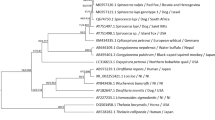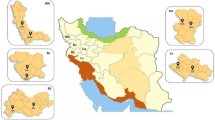Abstract
Purpose
The aim of this study is to conduct a molecular characterization of Spirometra tapeworm from jungle cat (Felis chaus) in Guilan Province, north of Iran using DNA sequence analysis of the mitochondrial cytochrome c oxidase subunit 1 (Cox1) and 12S rDNA sequences.
Methods
Morphological features of the adult tapeworm of Spirometra were evaluated using specific staining and light microscopy. The molecular characterization was performed using partial Cox1 and 12S rDNA regions. Genetic diversity was calculated and phylogenetic trees of the obtained sequences were constructed.
Results
Morphological features were compatible with previous description of adult Spirometra erinaceieuropaei. The Cox1 sequence of the specimen showed 100% similarity with S. erinaceieuropaei sequences in GenBank from Korea, China and Iran. Also, the 12S rDNA sequence revealed 99.7% similarity with S. erinaceieuropaei isolates from China and Japan. Intra-species variation within isolates of S. erinaceieuropaei was 0–1.4% and 0–4.6% for Cox1 and 12S rDNA genes, respectively.
Conclusion
This is the first report of molecular characterization of S. erinaceieuropaei in jungle cat, F. chaus in Iran. Jungle cat probably plays a major role as reservoir host in maintaining of this parasite in this area with favorable climate condition. Needs for further assessment on the role of appropriate hosts, especially intermediate/paratenic hosts as well as the potential risk of human infectivity with sparganosis is emphasized.





Similar content being viewed by others
Data Availability
The accession numbers of sequences deposited in GenBank.
References
Ndosi BA, Park H, Lee D, Choe S, Kang Y, Nath TC et al (2020) Morphological and molecular identification of Spirometra tapeworms (Cestoda: Diphyllobothriidae) from carnivorous mammals in the Serengeti and Selous ecosystems of Tanzania. Korean J Parasitol 58(6):653. https://doi.org/10.3347/kjp.2020.58.6.653
Beaver P, Jung R (1984) Cyclophyllidium tapeworm Clinical parasitology. 9th edn Philadelphia. PA: Lea and Febiger, pp 505–543
Bray RA, Jones A, Andersen KI (1994) Order Pseudophyllidea Carus, 1863. Keys to the cestode parasites of vertebrates. CAB International, Wallingford, pp 205–247
Liu Q, Li M-W, Wang Z-D, Zhao G-H, Zhu X-Q (2015) Human sparganosis, a neglected food borne zoonosis. Lancet Infect Dis 15(10):1226–1235. https://doi.org/10.1016/S1473-3099(15)00133-4
Cheng K-B, Gao B-L, Liu J-M, Xu J-F (2014) Pulmonary sparganosis mansoni: a case report from a non-endemic region. J Thorac Dis 6(6):E120. https://doi.org/10.3978/j.issn.2072-1439.2014.06.07
Cui J, Wang Y, Zhang X, Lin XM, Zhang HW, Wang ZQ et al (2017) A neglected risk for sparganosis: eating live tadpoles in central China. Infect Dis Poverty 6(03):69–72. https://doi.org/10.1186/s40249-017-0265-7
Li M-W, Lin H-Y, Xie W-T, Gao M-J, Huang Z-W, Wu J-P et al (2009) Enzootic sparganosis in Guangdong, People’s Republic of China. Emerg Infect Dis 15(8):1317. https://doi.org/10.3201/eid1508.090099
Murata K, Abe T, Gohda M, Inoue R, Ishii K, Wakabayashi Y et al (2007) Difficulty in diagnosing a case with apparent sequel cerebral sparganosis. Surg neurol 67(4):409–411. https://doi.org/10.1016/j.surneu.2006.06.056
He L, Fang Z-M, Xue T, Zhang E-F, An C-L (2019) Genetic identification of Spirometra erinaceieuropaei spargana in Liaoning and Hubei Provinces. PR China Korean J Parasitol 57(3):309–312. https://doi.org/10.3347/kjp.2019.57.3.309
Almeida GG, Coscarelli D, Melo MN, Melo AL, Pinto HA (2016) Molecular identification of Spirometra spp. (Cestoda: Diphyllobothriidae) in some wild animals from Brazil. Parasitol Int 65(5):428–431. https://doi.org/10.1016/j.parint.2016.05.014
Eom KS, Park H, Lee D, Choe S, Kang Y, Bia MM et al (2018) Molecular and morphologic identification of Spirometra ranarum found in the stool of African lion, Panthera leo in the Serengeti plain of Tanzania. The Korean J Parasitol 56(4):379. https://doi.org/10.3347/kjp.2018.56.4.379
Boonyasiri A, Cheunsuchon P, Suputtamongkol Y, Yamasaki H, Sanpool O, Maleewong W et al (2014) Nine human sparganosis cases in Thailand with molecular identification of causative parasite species. Am J Trop Med Hyg 91(2):389. https://doi.org/10.4269/ajtmh.14-0178
Jeon H-K, Park H, Lee D, Choe S, Kim K-H, Sohn W-M et al (2016) Genetic identification of Spirometra decipiens plerocercoids in terrestrial snakes from Korea and China. Korean J Parasitol 54(2):181. https://doi.org/10.3347/kjp.2016.54.2.181
Badri M, Eslahi AV, Majidiani H, Pirestani M (2017) Spirometra erinaceieuropaei in a wildcat (Felis silvestris) in Iran. Vet Parasitol Reg St 10:58–61. https://doi.org/10.1016/j.vprsr.2017.08.004
Sanei A, Mousavi M, Rabiee K, Khosravi MS, Julaee L, Gudarzi F, Jaafari B, Chalani M (2016) Distribution, characteristics and conservation of the jungle cat in Iran. CATnews, Special Issue, pp 51–55
Sunquist M, Sunquist F (2002) Jungle cat Felis chaus (Schreber, 1777). Wild Cats of the World. University of Chicago Press, Chicago, USA, pp 60–66
Baer J (1925) Contributions to the helminth fauna of South Africa. 11 & 12 reports on veterinary research. Government printing and stationery office, Union of South Africa, Pretoria, p 61136
Faust EC, Campbell HE, Kellogg CR (1929) Morphological and biological studies on the species of Diphyllobothrium in China. Am J Epidemiol 9(3):560–583. https://doi.org/10.1093/oxfordjournals.aje.a121670
Okamoto M, Iseto C, Shibahara T, Sato M, Wandra T, Craig P et al (2007) Intraspecific variation of Spirometra erinaceieuropaei and phylogenetic relationship between Spirometra and Diphyllobothrium inferred from mitochondrial CO1 gene sequences. Parasitol Int 56(3):235–238. https://doi.org/10.1016/j.parint.2007.03.003
Miyadera H, Kokaze A, Kuramochi T, Kita K, Machinami R, Noya O et al (2001) Phylogenetic identification of Sparganum proliferum as a pseudophyllidean cestode by the sequence analyses on mitochondrial COI and nuclear sdhB genes. Parasitol Int 50(2):93–104. https://doi.org/10.1016/S1383-5769(01)00071-X
https://technelysium.com.au/wp/chromas. Accessed 2023
Tamura K, Stecher G, Peterson D, Filipski A, Kumar S (2013) MEGA6: molecular evolutionary genetics analysis version 6.0. Mol Biol Evol 30(12):2725–2729. https://doi.org/10.1093/molbev/mst197
Jeon H-K, Park H, Lee D, Choe S, Eom KS (2018) Spirometra decipiens (Cestoda: Diphyllobothriidae) collected in a heavily infected stray cat from the Republic of Korea. Korean J Parasitol 56(1):87. https://doi.org/10.3347/kjp.2018.56.1.87
Müller-Graf CD (1995) A coprological survey of intestinal parasites of wild lions (Panthera leo) in the Serengeti and the Ngorongoro Crater, Tanzania, East Africa. J parasitol. https://doi.org/10.2307/3283987
Eom KS, Park H, Lee D, Choe S, Kang Y, Bia MM et al (2019) Identity of Spirometra theileri from a leopard (Panthera pardus) and spotted hyena (Crocuta crocuta) in Tanzania. Korean J Parasitol 57(6):639. https://doi.org/10.3347/kjp.2019.57.6.639
Mueller JF (1937) A repartition of the genus Diphyllobothrium. J parasitol. https://doi.org/10.2307/3272427
Iwata S (1972) Experimental and morphological studies of Manson’s tapeworm, Diphyllobothrium erinacei, Rudolphi. Special reference with its scientific name and relationship with Sparganum proliferum. Ijima Progr Med Parasitol Jpn 4:536–590
Liu W, Tan L, Huang Y, Li W, Liu Y, Yang L (2020) Prevalence and molecular characterization of Spirometra erinaceieuropaei spargana in snakes in Hunan Province. China J Helminthol 94:e131. https://doi.org/10.1017/S0022149X20000139
Zhang X, Wang H, Cui J, Jiang P, Lin ML, Zhang YL et al (2016) The phylogenetic diversity of Spirometra erinaceieuropaei isolates from southwest China revealed by multi genes. Acta Trop 156:108–114. https://doi.org/10.1016/j.actatropica.2016.01.012
Lillis WG, Burrows RB (1964) Natural infections of Spirometra mansonoides in New Jersey cats. J Parasitol. https://doi.org/10.2307/3276128
Ugarte C, Thomas D, Gasser R, Hu M, Scott I, Collett M (2005) Spirometra erinacei/S. erinaceieuropaei in a feral cat in Manawatu with chronic intermittent diarrhoea. New Zeal Vet J 53(5):347–351. https://doi.org/10.1080/00480169.2005.36573
Wei T, Zhang X, Cui J, Liu L, Jiang P, Wang Z (2015) Levels of sparganum infections and phylogenetic analysis of the tapeworm Spirometra erinaceieuropaei sparganum in wild frogs from Henan Province in central China. J Helminthol 89(4):433–438. https://doi.org/10.1017/S0022149X14000248
Bennett HM, Mok HP, Gkrania-Klotsas E, Tsai IJ, Stanley EJ, Antoun NM et al (2014) The genome of the sparganosis tapeworm Spirometra erinaceieuropaeiisolated from the biopsy of a migrating brain lesion. Genome Biol 15(11):1–18. https://doi.org/10.1186/s13059-014-0510-3
Tohidifar M, Moser M, Zehzad B, Ghadirian T (2016) Biodiversity of the hyrcanian forests. A Synthesis Report DO I:10
Liu W, Zhao G, Tan M, Zeng D, Wang K, Yuan Z et al (2010) Survey of Spirometra erinaceieuropaei spargana infection in the frog Rana nigromaculata of the Hunan Province of China. Vet Parasitol 173(1–2):152–156. https://doi.org/10.1016/j.vetpar.2010.06.005
Okino T, Ushirogawa H, Matoba K, Nishimatsu S-i, Saito M (2017) Establishment of the complete life cycle of Spirometra (Cestoda: Diphyllobothriidae) in the laboratory using a newly isolated triploid clone. Parasitol Int 66(2):116–118. https://doi.org/10.1016/j.parint.2016.12.011
Jeon H-K, Eom KS (2019) Mitochondrial DNA sequence variability of Spirometra species in Asian countries. Korean J Parasitol 57(5):481. https://doi.org/10.3347/kjp.2019.57.5.481
Waeschenbach A, Brabec J, Scholz T, Littlewood DTJ, Kuchta R (2017) The catholic taste of broad tapeworms–multiple routes to human infection. Int J Parasitol 47(13):831–843. https://doi.org/10.1016/j.ijpara.2017.06.004
Liu G-H, Li C, Li J-Y, Zhou D-H, Xiong R-C, Lin R-Q et al (2012) Characterization of the complete mitochondrial genome sequence of Spirometra erinaceieuropaei (Cestoda: Diphyllobothriidae) from China. Int J Biol Sci 8(5):640. https://doi.org/10.7150/ijbs.4096
Jeon H-K, Park H, Lee D, Choe S, Kang Y, Bia MM et al (2018) Genetic and morphologic identification of Spirometra ranarum in Myanmar. Korean J Parasitol 56(3):275. https://doi.org/10.3347/kjp.2018.56.3.275
Saksirisampant W, Eamudomkarn C, Jeon H-K, Eom KS, Assavapongpaiboon B, Sintuwong S et al (2020) Ocular sparganosis: the first report of Spirometra ranarum in Thailand. Korean J Parasitol 58(5):577. https://doi.org/10.3347/kjp.2020.58.5.577
Eom KS, Park H, Lee D, Choe S, Kim KH, Jeon HK (2015) Mitochondrial genome sequences of Spirometra erinaceieuropaei and S. decipiens (Cestoidea: Diphyllobothriidae). Korean J Parasitol 53(4):455. https://doi.org/10.3347/kjp.2015.53.4.455
Yamasaki H, Sanpool O, Rodpai R, Sadaow L, Laummaunwai P, Un M et al (2021) Spirometra species from Asia: genetic diversity and taxonomic challenges. Parasitol Int 80:102181. https://doi.org/10.1016/j.parint.2020.102181
Nakao M, Abmed D, Yamasaki H, Ito A (2007) Mitochondrial genomes of the human broad tapeworms Diphyllobothrium latum and Diphyllobothrium nihonkaiense (Cestoda: Diphyllobothriidae). Parasitol Res 101:233–236. https://doi.org/10.1007/s00436-006-0433-3
Acknowledgements
This study was performed as Ph.D. project of the first author (Mahboobeh Salimi) in the Department of Medical Parasitology and Mycology, School of Public Health, Tehran University of Medical Sciences.
Author information
Authors and Affiliations
Corresponding authors
Ethics declarations
Conflict of Interest
There are no conflicts to declare in this work.
Additional information
Publisher's Note
Springer Nature remains neutral with regard to jurisdictional claims in published maps and institutional affiliations.
Rights and permissions
Springer Nature or its licensor (e.g. a society or other partner) holds exclusive rights to this article under a publishing agreement with the author(s) or other rightsholder(s); author self-archiving of the accepted manuscript version of this article is solely governed by the terms of such publishing agreement and applicable law.
About this article
Cite this article
Salimi, M., Sharifdini, M. & Kia, E.B. Molecular Characterization of Spirometra erinaceieuropaei from Jungle Cat (Felis chaus) in North of Iran. Acta Parasit. 69, 574–582 (2024). https://doi.org/10.1007/s11686-023-00779-7
Received:
Accepted:
Published:
Issue Date:
DOI: https://doi.org/10.1007/s11686-023-00779-7




